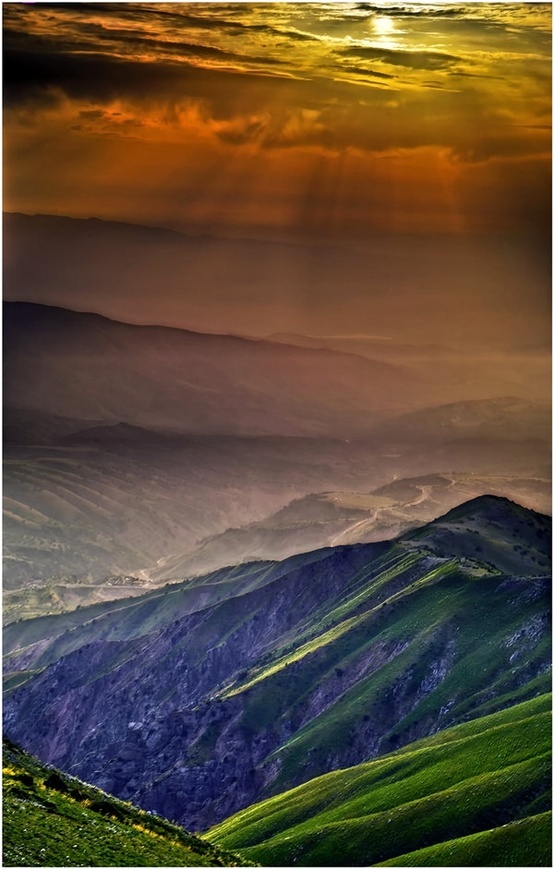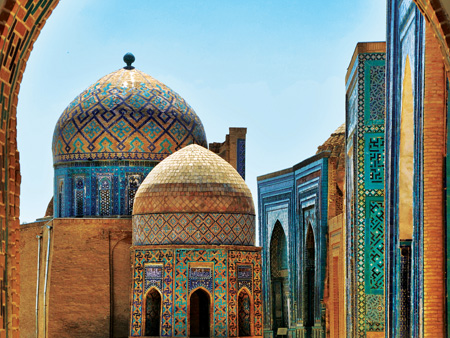 Uzbekistan embraces a different travel horizon backdrop unlike many of the world’s established tourist destinations. As one of the new nations of Central Asia, this former state under the USSR dominion possessed undoubtedly the best-developed tourism infrastructure in that region, thanks to its famed Silk Road cities, namely Tashkent, Bukhora and Samarkand which truly defined its new standing popularity today. Currently, a wide range of modern hotels and boutique guest houses, train connections, and reliable tour companies connect the region with the rest of the world and Uzbekistan is fast becoming a top class tourist destination.
Uzbekistan embraces a different travel horizon backdrop unlike many of the world’s established tourist destinations. As one of the new nations of Central Asia, this former state under the USSR dominion possessed undoubtedly the best-developed tourism infrastructure in that region, thanks to its famed Silk Road cities, namely Tashkent, Bukhora and Samarkand which truly defined its new standing popularity today. Currently, a wide range of modern hotels and boutique guest houses, train connections, and reliable tour companies connect the region with the rest of the world and Uzbekistan is fast becoming a top class tourist destination.
Since the airport was undergoing a major renovation exercise, visitors arriving at Tashkent International Airport (TAS) were taken by surprise by the long and disorganized queues at the immigration counters and baggage clearance terminals, which demonstrated a peculiar sudden stand still hitch of its operations. The premises, which was always under scrutiny by the authorities soon paved for a complete breather as we exited the premises in total transition. The fairly large modern aviation centre is located some 12 kms away from the city. Getting into and out of the airport area was assuringly convenient and comfortable as seen by the modern roads and highway that linked the aviation hub with the rest of the city.
Tashkent City
Tashkent is a city divided into two contrasting eras, the modern and the ancient. The city’s main underground station was built in 1977. It is the only city in Central Asia which has a subway system. The architectural and artistic decoration of each station reflects its distinguished metro line character namely, the Chilanzar, Uzbekistan and Yunus-Abad. The architecture of the Tashkent metro stations is one of the most beautiful in the world and it is a favourite mode of transport for tourists during sightseeing tours around the city. Generally the Uzbeks are friendly and welcoming, but tourists must always be wary of the local customs such as not putting bread down on the ground, avoiding displays of wealth such as jewelry, and wearing modest clothing in public places which will place the unassuming visitors in good stead here. Shopping in Uzbekistan’s many bazaars or local markets is a truly unique travel experience.The most popular bazaars in Tashkent include the “Eski Djouva” or “Chor Su” bazaars, located in the Old City. Tourists and bargain hunters can search for beautiful rugs, soft silk, intricate khan atlases, dried fruits, spices, handicrafts as well as Uzbek style souvenirs and traditional hand-made clothes and footwear. The most popular fruits that are most commonly sold in the markets include huge watermelons, succulent peaches, fresh cherries, pears, and apricots, as well as goodly nut varieties such as almonds, macadamias and pistachios.
Bukhara
It is the capital of the Bukhara Province of Uzbekistan, which was formerly a part of Turkmenistan. You will be amazed to recognize that Bukhara is a city-museum in itself, endowed with a rich legacy of more than 400 impressive architectural monuments conceived as part of its heritage wonders. It is the nation’s fifth-largest city, with a recorded population on April 24, 2014 of approximately 272, 000, people, and is hardly considered as congested according to international urban standards. It is good to know that the region around Bukhara has been inhabited for at least five millennia, and that the city has existed for half that time. Located along the renowned classic Silk Road of the caravanserai, the city has long been a center of trade, scholarship, culture, and religion. The historic center of Bukhara, which contains numerous mosques and madrasahs, have been acclaimed by by UNESCO as a custodian of a World Heritage site. In its heyday of transformation, Bukhara was a meeting point for various cultures including the Zoroastrians, Persians, Buddhists and Turk tribes. The delightful Lyabi-Khauz Ensemble, a showcase of Bukharan architecture and a local gathering place in the heart of the city exhibit a resplendent display of the glorious Islamic past as depicted in the magnificent Mogaki Attari Mosque. It was like a palatial renaissance of sorts because there is a mosque for every day of the year in Bukhara, including one of Uzbekistan’s most miraculous buildings: the 10th-century Ismail Samani mausoleum. The 18th-century Bolo Hauz mosque is captivatingly elegant, with 20 elm columns lining the waterside. An eye catching and spectacular structure called The Ark is a massive fortress located in the city of Bukha. It was initially built and occupied around the 5th century AD. By 500 AD it was already the residence of local rulers. Here, in the fastness of the citadel, lived the emirs, their chief viziers, military leaders and numerous servants. The Ark was used as a fortress until it fell to Russia in 1920. Currently, the ruins of the Ark is a tourist attraction and showcasing museums covering its impeccable history.
Samarkand
Samarkand is considered to have experienced its most significant development during the Timurid period that occurred from the 14th to 15th centuries. Samarkand was the capital of ancient Sogdiana, and is one of the oldest cities in the world. Located at the crossroads of the great trade routes that traversed the Central Asia region, Samarkand has a multi-millennial history and as history would have revealed it, the city was also a part of a Turkish kingdom in the 6th century, and was invaded by a Muslim conqueror named Kuteiba-ibn-Muslim in 712 CE, which catapult the penetration of Islamic culture into the region. A combination of Arabs rulers and the Samanids of Iran later emerged to cause physical and social changes through their administration by converting ancient temples into mosques, as well as introducing places of learning, courts, and treasuries within the state.
 In the later part of the centuries, the capital city was devastated by the Mongol invasion of Genghis Khan in 1220.The city emerged again as a major centre through the efforts of Timur the Lame (Tamerlane, c . 1336-1405). It was rebuilt on its present site, south-west of Afrosiab, and became the capital of Timur’s powerful state and the repository of the material riches from conquered territories that extended from Central Asia to Persia, Afghanistan and even India. In its current remains,the Registan Square, a medieval center of trade is arguably the most popular attraction here. Visitors will have the opportunity to see the three beautiful “madrasahs” built in the 13th, 15th and 16th centuries. The Bibi Khanum Mosque, and the Shakhi Zinda Necropolis, a pilgrimage site of more than 20 mausoleums built between the 11th-19th centuries is also another grand attraction, where you can see the finest samples of majolica, mosaic and terracotta tile work. Another remarkable must visit site is the fantastic Ulugbek Observatory, where Ulugbek and other scholars completed the famous “Tables of stars.”
In the later part of the centuries, the capital city was devastated by the Mongol invasion of Genghis Khan in 1220.The city emerged again as a major centre through the efforts of Timur the Lame (Tamerlane, c . 1336-1405). It was rebuilt on its present site, south-west of Afrosiab, and became the capital of Timur’s powerful state and the repository of the material riches from conquered territories that extended from Central Asia to Persia, Afghanistan and even India. In its current remains,the Registan Square, a medieval center of trade is arguably the most popular attraction here. Visitors will have the opportunity to see the three beautiful “madrasahs” built in the 13th, 15th and 16th centuries. The Bibi Khanum Mosque, and the Shakhi Zinda Necropolis, a pilgrimage site of more than 20 mausoleums built between the 11th-19th centuries is also another grand attraction, where you can see the finest samples of majolica, mosaic and terracotta tile work. Another remarkable must visit site is the fantastic Ulugbek Observatory, where Ulugbek and other scholars completed the famous “Tables of stars.”
BEST TIME TO VISIT
Uzbekistan has an extreme continental climate. It is generally warmer in the south and colder in the north. The average temperatures in December are -8°C (18°F) in the north and 0°C (32 °F) in the south while during the summer, temperatures can reach as high as 45°C (113°F) and above but humidity however is low. The Spring (April to June) and the Fall (September through October) are in general the most pleasant times to travel to the country. In the Fall, it is hailed as a reaping period where the markets are full of fresh agricultural produce and abundant seasonal harvest. If you are interested in trekking and some engaging physical adventure, then summer (July and August) is the most appropriate time because these months are almost dry. In recent years Uzbekistan was notably affected by the global warming and dry-out of the Aral Sea but this has not invariably affected travelers to visit the country and anytime is still the best time to visit this spell binding and magical country.
Article from SUTRA Newsletter, Issue 26:
https://www.sutra.my/wp-content/uploads/2015/04/Issue-26-Q4-2014.pdf




















